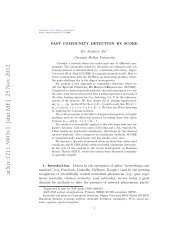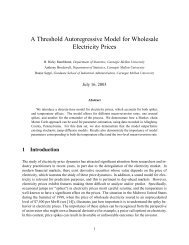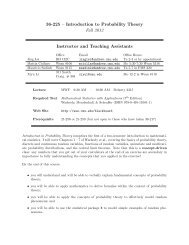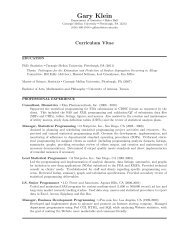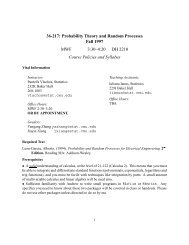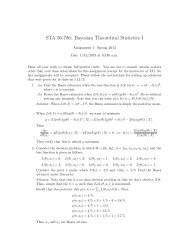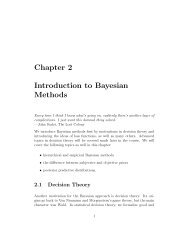Subjective Bayesian Analysis: Principles and Practice
Subjective Bayesian Analysis: Principles and Practice
Subjective Bayesian Analysis: Principles and Practice
Create successful ePaper yourself
Turn your PDF publications into a flip-book with our unique Google optimized e-Paper software.
Our approach has been implemented in software employed by several users in the oil<br />
industry, through our collaborators ESL (Energy SciTech Limited). This means that we<br />
get to keep track, just a little, of how the approach works in practice. Here’s an example<br />
of the type of success which ESL has reported to us. They were asked to match an oil<br />
field containing 650 wells, based on 1 million plus grid cells (for each of which permeability,<br />
porosity, fault lines, etc. are unknown inputs). Finding the previous best history match<br />
had taken one man-year of effort. Our <strong>Bayesian</strong> approach, starting from scratch, found a<br />
match using 32 runs (each lasting 4 hours <strong>and</strong> automatically chosen by the software), with a<br />
fourfold improvement according to the oil company measure of match quality. This kind of<br />
performance is impressive, although, of course, these remain very hard problems <strong>and</strong> much<br />
must still be done to make the approach more flexible, tractable <strong>and</strong> reliable.<br />
Applications such as these make it clear that careful representation of subjective beliefs<br />
can give much improved performance in tasks that people are already trying to do. There<br />
is an enormous territory where subjective Bayes methods are the only feasible way forward.<br />
This is not to discount the large amount of work that must often be done to bring an<br />
application into Bayes form, but simply to observe that for such applications there are no<br />
real alternatives. In such cases, the benefits from the <strong>Bayesian</strong> formulation are potentially<br />
very great <strong>and</strong> clearly demonstrable. The only remaining issue, therefore, is whether such<br />
benefits outweigh the efforts required to achieve them. This “pain to gain” ratio is crucial<br />
to the success of subjective Bayes applications. When the answer really matters, such as for<br />
global climate change, the pain threshold would have to be very high indeed to dissuade us<br />
from the analysis.<br />
By explicitly introducing our uncertainty about the ways in which our models fall short of<br />
reality, the subjective Bayes analysis also does something new <strong>and</strong> important. Only technical<br />
experts are concerned with how climate models behave, while everybody has an interest in<br />
how global climate will actually change. For example, the Guardian newspaper leader on<br />
Burying Carbon (Feb 3, 2005) tell us that “the chances of the Gulf Stream - the Atlantic<br />
thermohaline circulation that keeps Britain warm - shutting down are now thought to be<br />
greater than 50% ”. This sounds like something we should know. However, I am reasonably<br />
confident that no climate scientist has actually carried an uncertainty analysis which would<br />
be sufficient to provide a logical bedrock for such a statement. We can only use the analysis of<br />
a global climate model to guide rational policy towards climate change if we can construct a<br />
statement of uncertainty about the relation between analysis from the climate model <strong>and</strong> the<br />
behaviour of the real climate. To further complicate the assessment, there are many models<br />
for climate change in current use, all of whose analyses should be synthesised as the basis<br />
of any judgements about actual climate change. Specifying beliefs about the discrepancy<br />
between models <strong>and</strong> reality is unfamiliar <strong>and</strong> difficult. However, we cannot avoid this task if<br />
we want our statements to carry weight in the real world. A general framework for making<br />
such specifications is described in [8].<br />
3 Scientific subjectivism<br />
3.1 The role of subjectivism in scientific enquiry<br />
In the kind of applications we’ve discussed so far, the only serious issues about the role of<br />
subjectivity are pragmatic ones. Each aspect of the specification, whether part of the “likelihood<br />
function” or the “prior distribution”, encodes a collection of subjective judgements.<br />
The value of the <strong>Bayesian</strong> approach lies firstly in providing a language within which we<br />
can express all these judgements <strong>and</strong> secondly in providing a calculus for analysing these<br />
4



